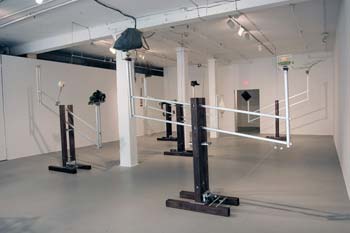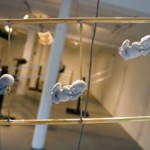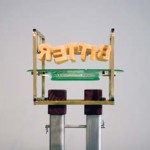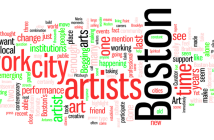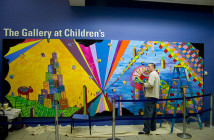Do all stories have a climax, breaking point, or fulcrum of sorts? Well, they all can, but how the story is spoken, written, played, drawn, or however the author, (whether they know they are an author not), mediates their story, can effect that story’s narrative. Furthermore, the audience’s interpretation of the narrative may (or may not) assign significance to an event or series of events that they identify as the point of the story where the conditions of the protagonist deviate enough from their previous conditions to warrant a state of satisfactory conclusivity. In some cases, that ‘tipping point’ is supplied by a medium in order to give the narrative palpable sense of story. For the current exhibition at the Mills Gallery, “Tipping Point: Health Narratives from the South End,” the Social Anthropologist Ellen S. Ginsburg, Ph.D sought out “informants” with a story to tell about their health. From the stories they told, she interpreted a ‘health narrative’ and intuited a tipping point or ‘transformative event’ whereby their lives were changed significantly.
It’s not hard to imagine a health narrative, as there are two definitive states of the protagonist: sick or injured and healthy, with their convalescence making a logical trajectory for the story. It also a story we are all quite familiar with on a personal level and metaphorical level as health is applied to our own country’s economy and international exploits. An ethnography of sorts, on the hurdles and daily routines of individuals coping with varied states of health is a project that rings of the same universality and insights of a Studs Terkel project. The artists even mechanized the pieces and programmed their motors to respond to movement sensed by infrared sensors in the gallery, creating a more interactive piece. The pieces are seesaw-like structures with items placed on either side to connote different sides of a narrative’s tipping point. When viewers enter the gallery, the infrared sensors send signals to a computer that controls all the pieces’ movements. In one piece, a fetus is situated in the middle of a clear sphere with a metal rod through its head. Evenly spaced across the seesaw section of the piece are more fetuses displayed in the same fashion, though without the sphere. The work is about an artist whose work was forever changed by a first pregnancy that resulted in a stillborn child. I admit it is not easy to match each one of the seven pieces to its corresponding story, which is supplied in the show’s literature. Though, this is due to the many layers if mediation each story went through before it reached its final product: first, the artist-informant mediates their memory with the story they give to the ethnographer, then the ethnographer, Ginsburg, interprets the story into a narrative which is supplied to three artists. Artists Jennifer Hall and Blyth Hazen take inspiration from the narrative and create the seesaw like structures for which Arnaldo Hernandez programmed viewer-interactive movement.
Narrative itself is a coping mechanism for anyone who has undergone physical or emotional trauma. In fact, genres themselves are the very stories that develop out of a culture’s grappling with its fears and desires. A pretense of healing is unmistakable in the show’s conceptual founding; yet the implicit narrative to healing is not apparent. As Ginsburg states, “Narrative is often indispensable in helping us grasp what our deepest values are.” However, the values, those of the well being sought in an individual in the midst of a health narrative, those that I believe the works are seeking to accent, are hidden in the abstruse poetry of the works. Ethnographers give an individual or ethnic group a certain narrativity so the ethnographer’s audience can better understand that individual.
Successful? I don’t believe so, and right now I’m too tired to help you further in making your own decision. In the midst of my own “health narrative,” my state of fatigue is prevents me from going on. You see, humans have somehow not evolved to a state where they don’t suffer from allergies and this year, my own allergies to tree pollen seem to have gotten the best of me. The symptoms of hay fever (excessive mucous, itchy eyes and nose) and the stuff I used to treat it—which causes dehydration and a certain fuzziness to reality, as I know it—have given way to quite a head cold. Over the past week a microbe invaded my sinuses and within the last couple days has succeeded in colonizing them to a degree that has put me in a rather uncomfortable state. For my entire health history, I’ve been seeking my own tipping point to lead me to a successful way to treat my condition, but so far I’ve been unsuccessful.
Links:
Mills Gallery
Tipping Point Website
World Allergy Organization
"Tipping Point: Health Narratives from the South End" is on view April 7 - May 28, 2006 at The Mills Gallery of the Boston Center for the Arts.
All images are courtesy of the artists and The Mills Gallery.

